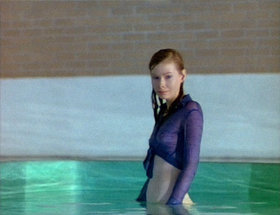It seems likely that, for Lars von Trier, The Idiots is both the beginning and ending of Dogme 95, the set of back-to-basics aesthetic principles he helped concoct. Certainly his next project, a lavish musical starring Björk, falls outside the Dogme 95 purview. Stipulating natural lighting, natural sound, and the absence of props or special effects, the Dogme restrictions supposedly spur directors to new creative thought by making them re-evaluate the importance of character and story in an era where world cinema is more and more dominated by Hollywood-style artifice.
The first such production seen by American audiences was Thomas Vinterberg's skeletons-in-the-family-closets drama The Celebration (Festen,1998), a simple, compelling story that this film aesthete would have preferred had it been shot on film rather than distractingly grainy digital video. Also shot on video, but under less challenging conditions, The Idiots premiered with The Celebration at the 1998 Cannes Film Festival and was purchased by October Films for U.S. distribution. October has since become USA Films, The Idiots is only now being released in this country, partly due to a rating controversy.
Specifically, the film, which depicts a group of friends who engage in a form of protest by feigning mental retardation as a practical joke, includes one scene where the rules of their small society break down and these "idiots" begin having sex with one another — explicitly, on camera. Rather than risk a limited, unrated release, Romance-style, USA opted instead to edit the picture for an R rating. (Last year, the same company purchased, then declined to release, Todd Solondz' NC-17 Happiness.) Through consultation with the director, it was decided that ugly black boxes would be placed over the image any time actual penetration took place, or whenever a penis could be sighted, to semi-comic effect. (If only USA had the bills to pay for digital idiots, a la the cloaked figures who obscured our view of the good stuff in Eyes Wide Shut.)
I'd like to hear someone at USA Films explain exactly how many tickets they feel they can to sell to 16-year-old kids, or why they thought it fiscally prudent to edit the film's most publicity-friendly content, but never mind that. The low-tech intrusion of black boxes underscores the film's documentary feel. Perhaps inadvertently, it heightens the sense that what we're seeing is less a narrative than a filmed experiment in which a small group of actors, enlisted in a dogmatic exercise in moviemaking, pretend to be performance artists and, eventually, have sex on camera — an extraordinary demand of any mainstream performer.
The clinical nature of this project is broken up a bit by the presence of Karen (Bodil Jørgensen), an outsider (and therefore audience surrogate) who quite unintentionally hooks up with the group after they successfully disturb a group of restaurant diners. Disturbance is the name of the game — these folks, who describe their technique as "spassing," take their pleasure in confronting ordinary people with bogus portrayals of the aggressively feeble-minded, presumably to expose the weakness and/or hypocrisy of the victim's reactions. They strike at swimming pools, factory tours, and conspire to throw the nice woman who wants to purchase their communal house (it's owned by a parent of one of the spassers) off the track by suggesting that the residents of a nearby group home like to linger in the garden.
The ringleader, Stoffer (Jens Albinus) concocts a philosophically complicated (that's a polite way of saying "bullshit") justification for these actions—something about getting in touch with your "inner idiot"—that reminded me of the nattering of Crash's Elias Koteas, who led a similar underground collective in that film.
In reality, however, these ostensibly daring souls who rail against the bourgeoisie are themselves the idiots. They react none too confidently when forced to socialize with actual mentally handicapped people (here, as in his depiction of Karen, the director seems to celebrate the same ideal of innocence that drove Breaking the Waves). At one point, the youthful frivolity of their endeavor is exposed as one angry parent arrives to collect his daughter; she complies without a struggle though her comrades rail impressively against her departure, and despite her newfound romantic entanglement with another member of the collective.
Their lack of dedication is bemoaned by Stoffer himself when he dares his comrades to return to their middle-class lives and jobs but continue acting out—to adhere to their dubious principles in their own lives, where it counts, rather than in those of others. Only the initially reluctant Karen, who winds up being the most thoughtful of all these provocateurs, takes him up on his challenge, with painful and cathartic results. Her experience displaces the hi-jinks from the realm of privileged youth into a broken family setting that may be overstated for effect, but still feels very real, especially in contrast to the idealized slacker lifestyle represented in the rest of the film. It's a potent, disorienting conclusion to this parable of arrogance, dysfunction and misguided rebellion.








Leave a comment